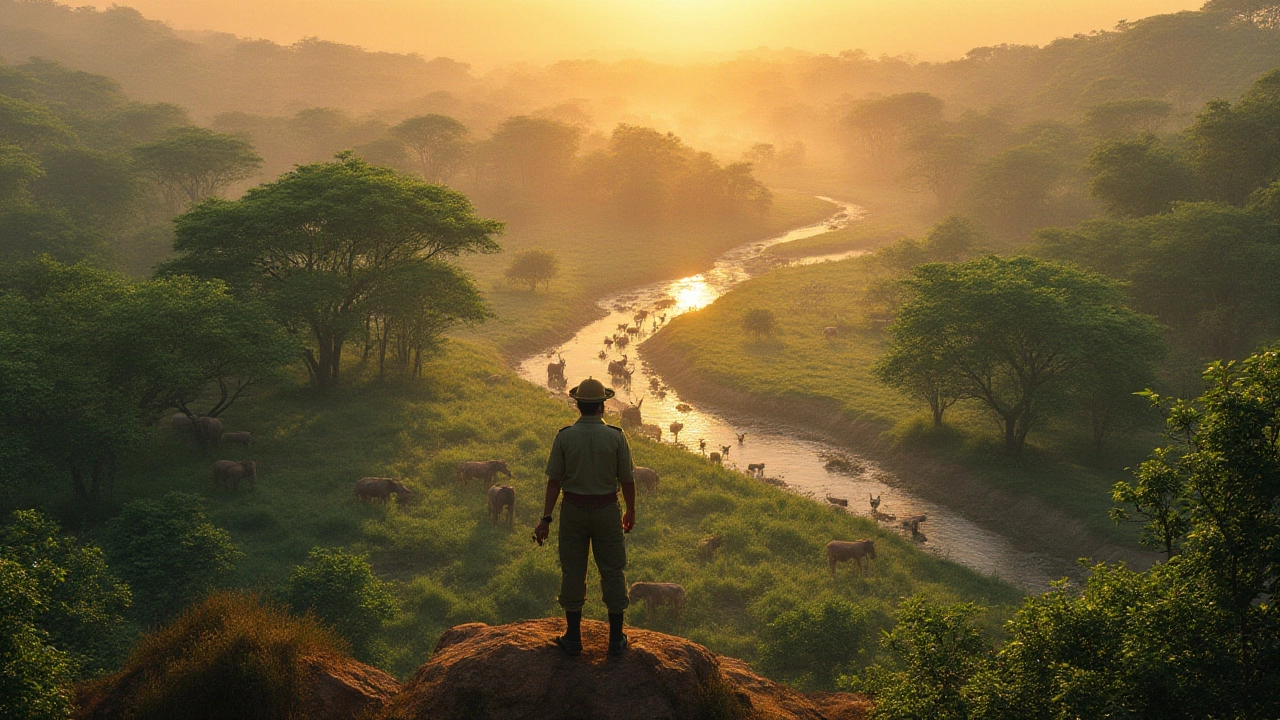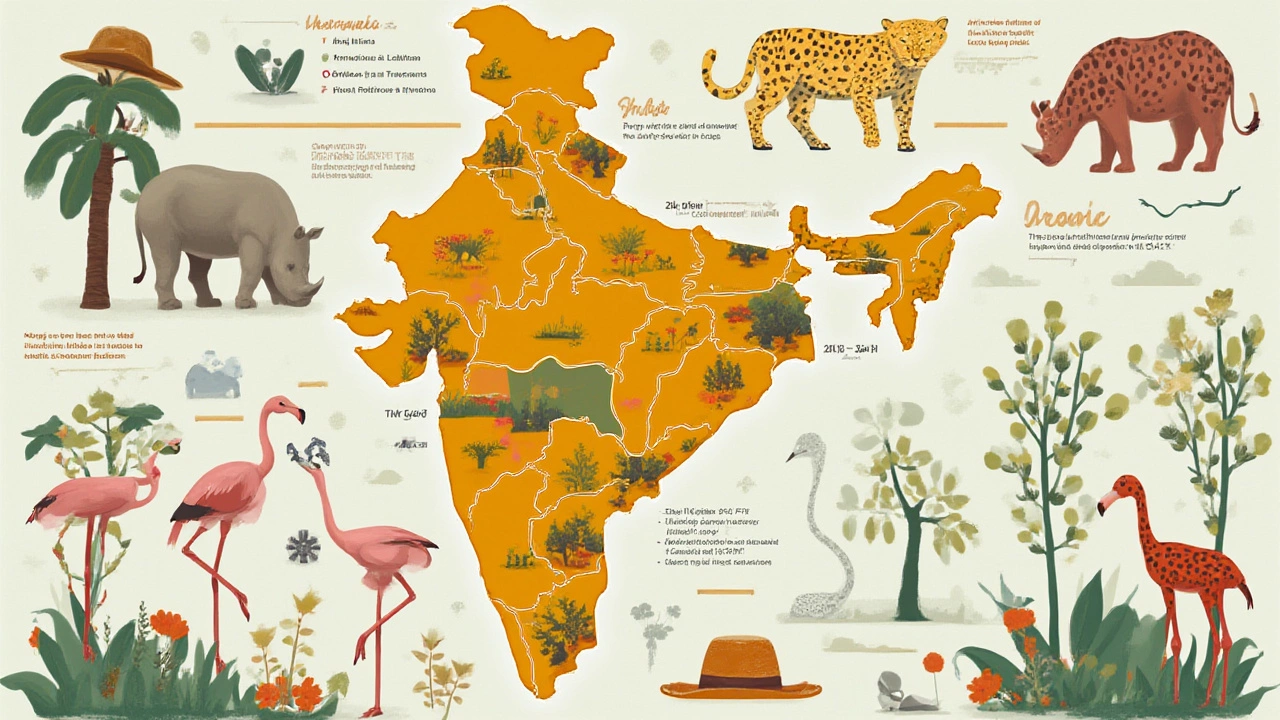Top Indian States with the Most Wildlife Sanctuaries: A 2025 Guide
 Jul, 23 2025
Jul, 23 2025
The sheer number of wildlife sanctuaries in India would blow your mind. You may think you know the usual suspects—Kerala, Madhya Pradesh, maybe Assam for its rhinos—but hold on, the title for “state with the most wildlife sanctuaries” will throw you a curveball. Picture this: a single state, crisscrossed with forests, rivers, and wild places, counted as home to nearly 50 official sanctuaries. You read that right. No zoo vibes, no concrete cages, just raw nature. Guess what? It’s West Bengal that tops the chart. Surprised? I was, too, until I dug into the numbers and the whys. With 48 wildlife sanctuaries as of 2025, West Bengal sits at the top, followed closely by the likes of Andhra Pradesh, Maharashtra, and Tamil Nadu.
West Bengal: India’s Wildlife Sanctuary Powerhouse
Think of West Bengal and chances are you picture Kolkata’s chaos or Darjeeling’s tea gardens. But let’s widen the lens. This state is an underrated wildlife titan, stretching from the Sundarbans’ tangled mangroves to the Himalayan foothills. The Sundarbans alone, with its crocodile-infested waterways and elusive Bengal tigers, could have its own movie franchise. But that’s just the start. There’s the Buxa Tiger Reserve, famous for its clouded leopards and smuggler legends. Then the Jaldapara Wildlife Sanctuary, elephant central and every birder’s daydream, is packed with rhinos, peacocks, and riverine forests that look straight out of The Jungle Book.
Here’s something to chew on: West Bengal is small compared to Rajasthan or Madhya Pradesh, but it compensates with diversity. Sanctuaries here protect not just major animals like tigers and elephants, but shy creatures—like the critically endangered hispid hare, spotted only by the hyper-patient. Let’s not forget the smaller but equally wild places: Ballavpur, with its blackbucks bouncing around; Bethuadahari, swarming with pythons and lesser-known deer; and Ramnabagan, where the kids can see rescued animals up close. Last time I took Thaddeus to the Narendrapur Wildlife Sanctuary, he mistook the jackals by the tree line for foxes and wouldn’t believe me until the ranger showed him the difference—jackal howls are way creepier than fox yips, let me tell you.
Thanks to its tangled rivers and shifting altitudes, West Bengal also shields rare wetland birds, which camp here during their frantic migrations. Names like Sajnakhali, Raiganj, and Haliday Island flicker on the bird-watcher’s map. And if you’re into lists—here’s a quick stat table for you:
| State | Number of Wildlife Sanctuaries (2025) |
|---|---|
| West Bengal | 48 |
| Andhra Pradesh | 38 |
| Maharashtra | 42 |
| Tamil Nadu | 35 |
| Madhya Pradesh | 25 |
| Kerala | 19 |
Keep in mind: just counting sanctuaries doesn’t tell the full story. Some of West Bengal’s protected areas are tiny, designed to protect one or two threatened creatures, while others, like Sundarbans, sprawl over hundreds of square kilometers, defending entire ecosystems. That mix is what keeps the region’s wildlife legacy unique.

What Sets Wildlife Sanctuaries Apart (and Why You Should Care)
Ever noticed how wildlife sanctuaries aren’t the same as national parks? Sure, both shield animals from people with itchy trigger fingers, but sanctuaries offer more flexibility. Local communities sometimes live inside or near them, grazing livestock or collecting forest produce in sustainable ways. That’s true across India, and West Bengal exemplifies this blend better than most places. Sanctuaries put the focus on preservation, but allow for some controlled human activity; that’s why the number’s higher than national parks, which lean more ‘strictly hands off’.
This openness makes for unexpected finds. In sanctuaries like Sunderbans, you’ll see honey gatherers, fishermen, and forest dwellers coexisting alongside wild boars, monitor lizards, and saltwater crocodiles. In many of these protected areas, local guides—often the real experts, way more interesting than any brochure—can point you to footprints, scratching posts, and bird calls you’d definitely miss. My advice: bring a kid (if you have one!), hand them a pair of binoculars, and watch them lose their minds over a hornbill or otter.
Sanctuaries also serve a big purpose you might not see at first. They act as stepping stones for animals moving between bigger, more strictly protected areas. That’s key, especially for far-roaming tigers and elephants or migratory birds. Even with nearly 570 wildlife sanctuaries dotting India’s map by 2025, fragmentation is still a threat. Sanctuaries knit together these cut-up wild landscapes into actual, functioning homelands for animals—think of them as safe havens on a marathon route.
If you want insider tips, here’s what I recommend:
- Visit in early morning or late afternoon—most animals are snoozing midday.
- Hire a local guide, not just for animal sightings, but for those quirky facts you won’t get anywhere else.
- Pack quick snacks and gear for the unexpected—light rain, leeches, or even a sudden line of elephants.
- Use eco-friendly transport when you can: many sanctuaries have cycle or electric rickshaw tours now.
- Leave no trace. Seriously, even orange peels mess up animal diets.

Beyond Bengal: How Other States Compare and the Future for Indian Wildlife Sanctuaries
So, West Bengal takes the crown for the most wildlife sanctuaries, but what about the runner-ups? Maharashtra and Andhra Pradesh have also doubled down on expansion, clocking in at 42 and 38 sanctuaries each. There’s a pattern here: states with a blend of dense populations, large forests, and forward-looking policies tend to have higher numbers. Take Maharashtra—between Tadoba’s tiger landscapes and Jayakwadi’s peaceful wetlands, you get every kind of wild experience stacked together, from sweaty jungle safaris to serene boat rides. Andhra Pradesh has quietly grown its count, with areas like Pulicat Lake bristling with flamingos and seahorses, which I used to think only existed in storybooks until Thaddeus proved me wrong by spotting two in one trip.
Now, Tamil Nadu and Madhya Pradesh are no slouches, either. Tamil Nadu’s pitch-perfect example is the Point Calimere Sanctuary, where blackbucks sprint past herds of flamingos, and pelicans squat like grumpy uncles. Madhya Pradesh, though not leading in sheer number, is a heavyweight with Kumaon and Pench standing out for tiger conservation. There, sanctuaries are often larger—less, but sprawling, with more emphasis on keeping animal populations healthy and stable.
What blows my mind is how these states deploy sanctuaries for different conservation needs. Some are created for single-species focus, like Orissa with its Olive Ridley turtles, others for habitats as fragile as high-altitude Himalayan forests. Even tiny Union Territories play a role—Lakshadweep has sanctuaries for its coral reefs and nesting birds, while Delhi fits in Asola Bhatti Wildlife Sanctuary in its urban maze.
So, let’s talk the future: the Indian government has pledged to get the sanctuary tally up as part of its ‘biodiversity mission 2030.’ And the best part is, technology’s making this easier—now, everything from drone cameras to movement sensors tracks the animals while disturbing them less. Grassroots projects hook in local schools for awareness and community buy-in, so more sanctuaries actually stick around.
Thinking of visiting? Here’s a pro tip: don’t just visit the ‘famous’ ones. Some of the smallest sanctuaries offer the wildest surprises—like the time we stumbled across a rare pangolin in a patch of forest in Tamil Nadu, right beside a tea stall and a cricket pitch. Turns out conservation and chaos can share a fence line.
So, wherever you live or travel in India, there’s a sanctuary waiting for you—often less than a day’s ride from any big city. West Bengal just happens to be the wildest of the wild, at least if you’re counting sanctuaries. The numbers, the stories, and the creatures you meet along the way are just the start. Pack your curiosity, your sense of adventure, and always—always—a pair of dry socks.